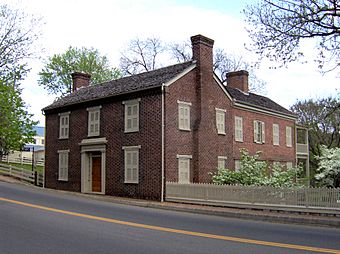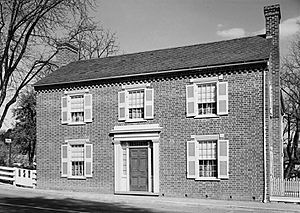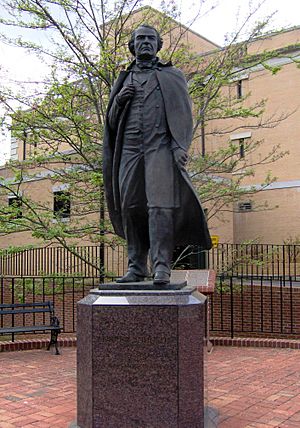Andrew Johnson National Historic Site facts for kids
Quick facts for kids |
|
|
Andrew Johnson National Historic Site
|
|

One of Andrew Johnson's homes
|
|
| Location | Greeneville, Tennessee |
|---|---|
| Area | 16.68 acres (0.0675 km2) |
| Built | 1830 |
| Architect | War Department |
| Architectural style | Colonial Revival |
| Visitation | 51,189 (2019) |
| Website | Andrew Johnson National Historic Site |
| NRHP reference No. | 66000073 |
| Added to NRHP | October 15, 1966 |
The Andrew Johnson National Historic Site is a special place in Greeneville, Tennessee. The National Park Service takes care of it. This site honors Andrew Johnson, who was the 17th president of the United States. He became president after Abraham Lincoln was sadly killed.
The historic site includes two of Johnson's old homes. You can also see his tailor shop and his burial place. These are all found within the Andrew Johnson National Cemetery. Johnson's wife, Eliza McCardle Johnson, and his son, Colonel Robert Johnson, are also buried there. Other family members, like David T. Patterson, a senator, are also laid to rest in the cemetery.
Congress first made this a U.S. National Monument in 1935. It officially opened on April 27, 1942. Later, on December 11, 1963, it became a National Historic Site.
Contents
Visiting the Andrew Johnson Site
Today, the site covers about 16 acres. It has three main parts for visitors to explore. These parts are the Andrew Johnson Visitor Complex, the Andrew Johnson Homestead, and the Andrew Johnson National Cemetery.
When you visit, you get a copy of an old ticket. This ticket was for Johnson's impeachment hearings. Impeachment is when a government official is accused of doing something wrong. Every year on May 26, visitors get to vote. They decide if they think Johnson should have been removed from office.
The Visitor Complex and Tailor Shop
The Andrew Johnson Visitor Complex has a visitor center and a museum. It also includes Andrew Johnson's tailor shop. At the visitor center, you can watch a short film. It tells you about Johnson's life in Greeneville.
The tailor shop looks much like it did when Johnson worked there. It is a small, one-room building. A special memorial building was built around it in 1923. This helps protect the old tailor shop from weather and time. Kids can even become Junior Rangers here. They just need to complete a fun activity book.
Andrew Johnson's very first home in Greeneville is also nearby. It is right across the street from the visitor complex.
Exploring the Johnson Homestead
The Andrew Johnson Homestead is kept just as it looked. This is how it was when Andrew Johnson and his wife lived there. They lived in this house from 1869 to 1875. Johnson bought the home in 1851.
During the Civil War, soldiers stayed in the house. It needed many repairs when the Johnson family returned. This was after Johnson finished being president in 1869. It is a two-story brick house built in the Greek Revival style.
The Andrew Johnson National Cemetery
The Andrew Johnson National Cemetery was created in 1906. Andrew Johnson owned 23 acres of land outside Greeneville. This land was on a place called Signal Hill. When he passed away in 1875, Johnson was buried on this property.
On June 5, 1878, a tall marble statue was put up. It was 28-foot (8.5 m) high and honored Johnson at his grave. This monument was so big that the hill's name changed. It became known as "Monument Hill."
Johnson's daughter, Martha Johnson Patterson, inherited the land. In 1898, she wanted the land to become a park. In 1900, she worked to make it a national cemetery. This way, the government would take care of it, not just her family. The United States Congress agreed in 1906. By 1908, the United States War Department was in charge. Later, on May 23, 1942, the National Park Service took control of the cemetery.
More to See





